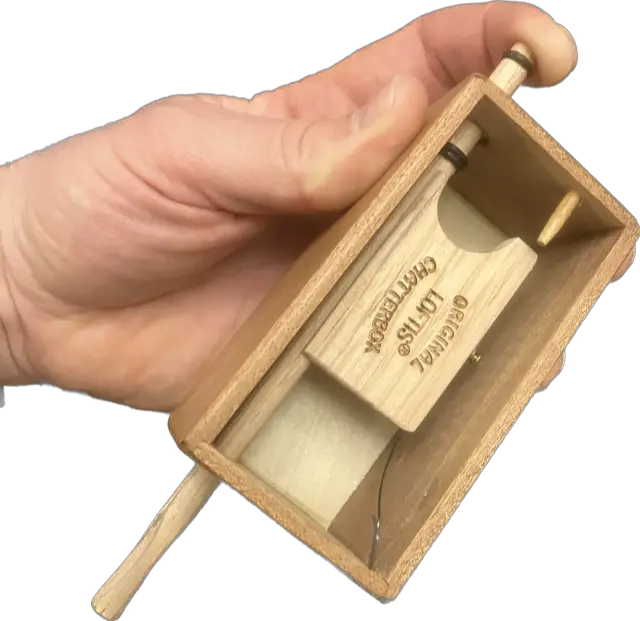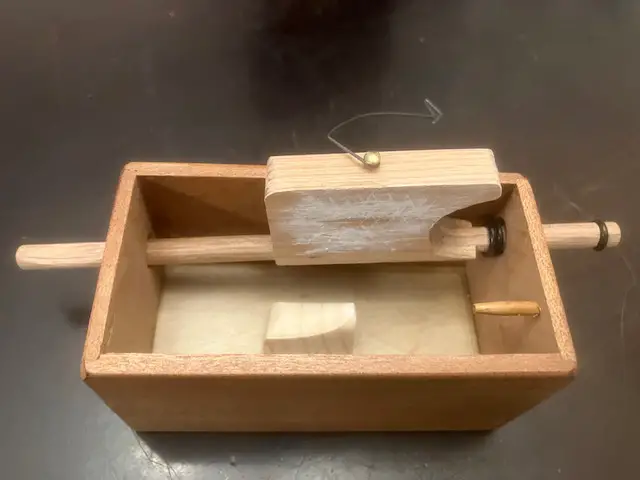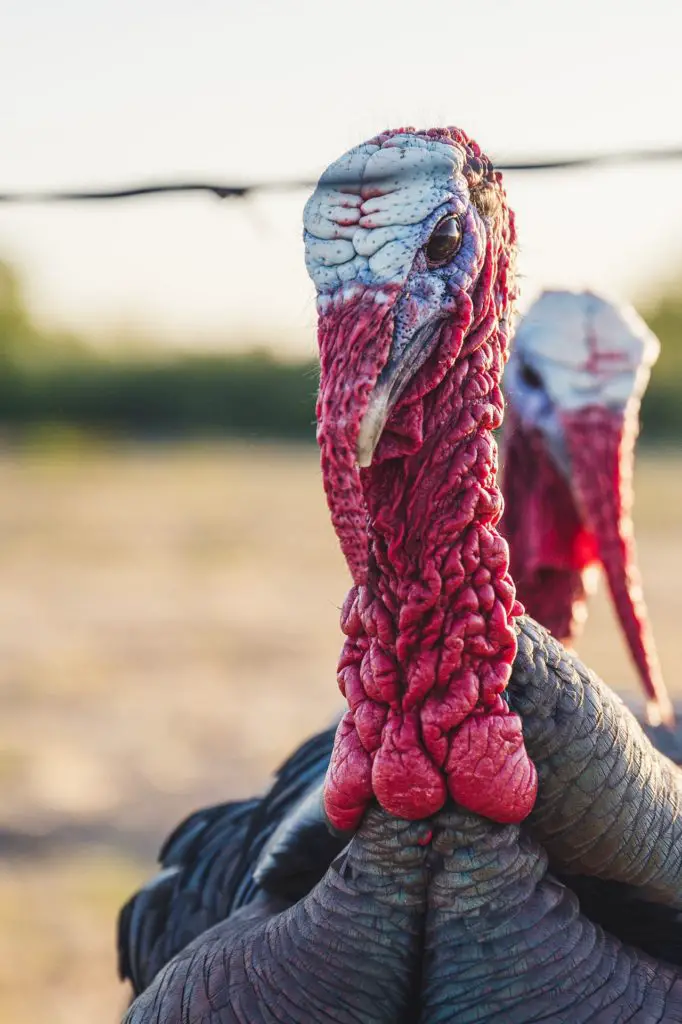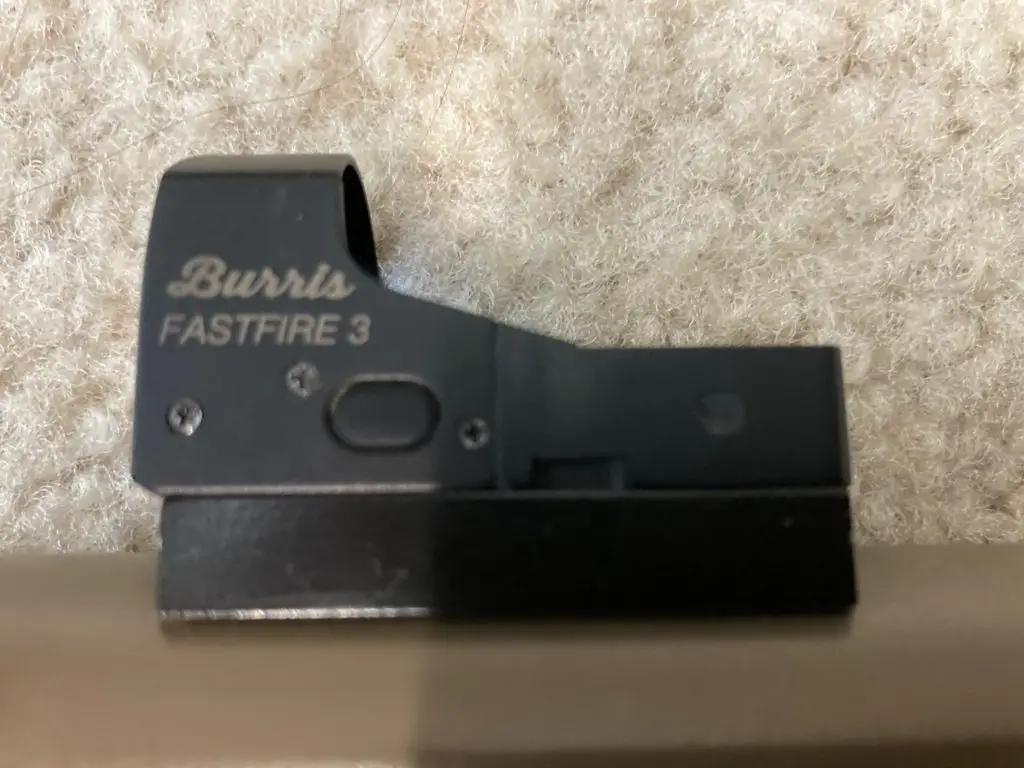
Remember those Staples commercials advertising the “easy button?” What if there was an easy button for turkey hunting?
The push button turkey call, also known as a push pin turkey call, may well be the closest thing you will find to an easy button in turkey hunting. Long marketed as a beginner’s call, it is an oft-overlooked, but highly effective call for hunters of any experience.
The push button turkey call is the red-headed stepchild of turkey calls. Not as popular as the pot or the box call. Not as stylish as the mouth call. Not as sexy as the trumpet call.
But that shouldn’t stop you from trying one. Regardless of your experience level, here are some reasons you should consider trying a push pin turkey call. Keep reading to learn how to use them and which models I recommend.
Benefits of a Push Pin Turkey Call
- The push button turkey call is easy to learn. The techniques to create yelps, clucks, and purrs can be picked up in minutes. As with most calls, the hard part is mastering the cadence.
- Push pin turkey calls can be operated with one hand. This is great for times when you are attempting to shoulder a shotgun while calling. It is especially great if you aren’t comfortable with a mouth call yet.
- Push pin turkey calls are smaller than traditional box calls so they are more practical when carrying in the field.
- Push button turkey calls are not as common amongst hunters as other friction-type calls. This allows you to present unique calling to high-pressured turkeys.

How Does a Push Button Turkey Call Work?
The push button turkey call is a five-sided, rectangular box. One of the long sides is open. We will refer to the open side as the top of the call.
Mounted to the bottom of the call, is an anvil-shaped piece. This is the striker or striking block.
Just above this is generally a square piece of wood or metal known as a paddle. The paddle is suspended by two dowels (called plungers) extending out through holes on either side of the box. The paddle scrapes against the striking block to produce the sound.
Push pin turkey calls will have either a spring or a rubber band to return the paddle to its original position after it is depressed. This allows the user to yelp in sequence or cut rapidly.
How To Use a Push Button Turkey Call
As previously mentioned, it is not hard to learn to use a push pin turkey call. Most people will engage the call by pressing the outer tip of the plunger against the resistance of the spring or rubber band.
However, I like to put my index finger on the tip of the paddle. Many calls have a cut-out on the paddle for this purpose.
It is generally recommended to grip the call on the sides of the box. The bottom of the call is the soundboard. Touching the soundboard can alter the sound. There are some people who will intentionally lay their palm across the bottom of the call for softer calling. Try it for yourself when you’re practicing to see if you like it.
If you want to vary the pitch of your call, you can use your non-calling hand to apply a slight pressure to the top of the paddle. You can then press the plunger and you will hear a higher-pitched call.
Here is how to make the various turkey sounds with a push button turkey call:
- Yelp- If you can yelp, you can kill a turkey. Make this sound by pushing the plunger or paddle until you hear the front and back end notes of a yelp. It will be a longer motion than the cluck. This is generally done in three to eight-yelp sequences.
- Cluck- To cluck on a push pin turkey call, press the plunger or paddle in a shorter, quicker motion than the yelp. It should be just one note.
- Cutting- Cutting is simply a series of clucks. Press the plunger or paddle in repeatedly, allowing it to retract slightly between notes.
- Purring- You can purr on your push pin turkey call by slowly pressing the plunger or paddle down so that it slips along the striker.
Conditioning and Caring for Your Push Pin Turkey Call
Push pin turkey calls do not need a lot of maintenance to keep them running well.
Like most calls, keep them out of extreme elements. Avoid leaving your call in a hot car. Try to keep your call from getting wet, but if it does, be sure to set it out to dry at normal room temperatures before storing.
If the paddle is getting slick, you can add some chalk to the underside of the paddle. Use dry chalk designed for the task. Keep in mind that a little goes a long way.
Not happy with the pitch of the call? Adjust the striker block by tightening or loosening the screw on the backside. Be very careful messing with this. If there’s not a problem, it’s generally best to let it be.
Choosing the Best Push Button Turkey Call
Determining the best push button turkey call is obviously a subjective experience. However, there are way fewer people producing them than box, pot, and mouth calls so we can certainly narrow it down a bit.
I have suggested three of my favorites below. Each has differing levels of price and availability.

Best Production Push Button Turkey Call
Quaker Boy Easy Yelper (Original Wood Design)
Quaker Boy’s classic design of maple and mahogany allows you to get a decent call at a very low price. Like most push pin turkey calls it can be operated one-handed. It’s also very compact for stowing in your turkey vest.
Compared to many of the other push button turkey calls on the market, I think the Quaker Boy Easy Yelper sounds a little bit better. Like most production calls, you never know if you’re going to get a good one or a bad one out of the box, but at this price point, you might be able to try out a couple.
If you’re going the Quaker Boy Easy Yelper route, stay away from the waterproof, cyclone, or any other versions of this call. It is hard to make synthetic materials sound as good as wood when it comes to push button turkey calls.
Best Custom Push Button Turkey Call That You Can Actually Get Your Hands On
Loftis Chatterbox
David Loftis made his first Chatterbox in the late 1970s. It has been killing turkeys ever since.
With a little bigger box than most other push button turkey calls, the Loftis Chatterbox sounds really good. As you can tell from my pictures above, the Chatterbox has an extra peg coming out of the side. You can lock the paddle into this peg to keep it quiet as it rides in your turkey vest.
I received one of these as a secret Santa gift this Christmas. I have been impressed with it, but we will see what the turkeys think of it this spring.
If you go to the Loftis website, you can order the Chatterbox for 50 dollars. It’s not a long wait time to receive one, unlike many other custom turkey calls.
Best Custom Push Button Turkey Call That is Very Hard to Find
Shannon Kelly (Old Gobbler)
Shannon Kelly’s custom push button turkey calls are hard to get your hands on (or even one hand since we’re talking push button calls). If you do get the chance to play one, I’m sure you will agree that they sound and look amazing.
Unlike most other push pin turkey calls, Kelly makes his calls out of a variety of exotic woods such as Macassar ebony and blackwood. He also adds a slide-out top that protects the internals of the call when it’s not in use.
These days Kelly has limited his distribution to select members of his forum, Old Gobbler. However, you may be able to find them for sale on eBay or the classified sections of turkey forums. Be warned, these calls are selling for 400 dollars plus!
Watch the video below to see and hear Kelly’s call. You will also get a great tutorial on how to use a push pin turkey call.


